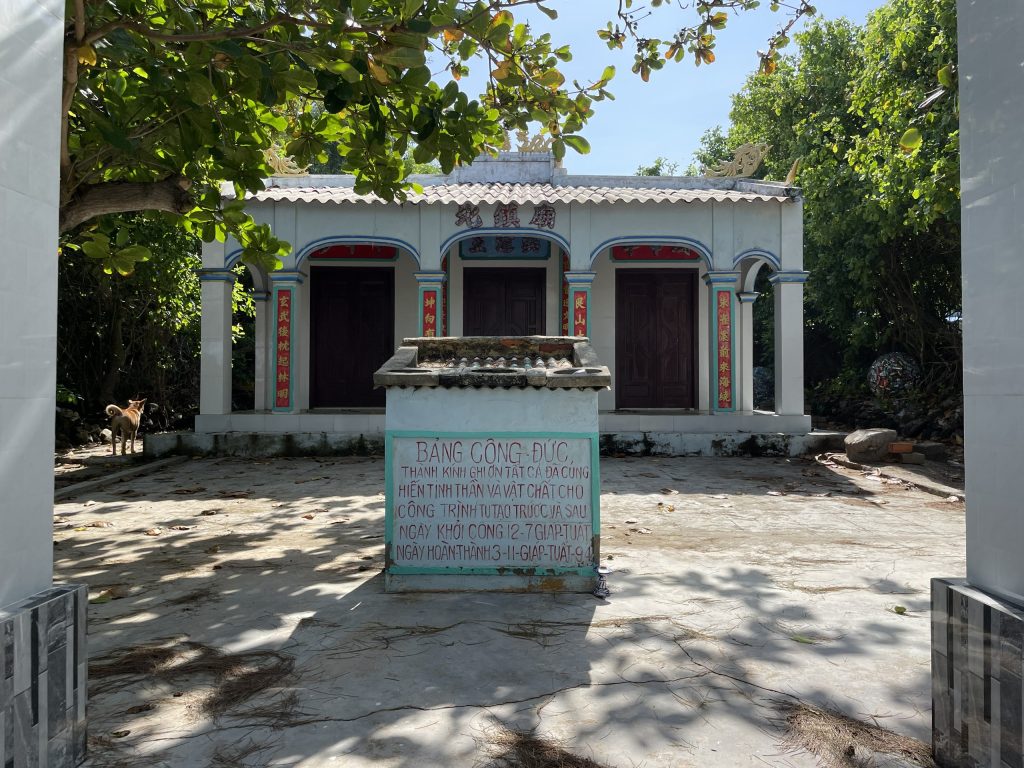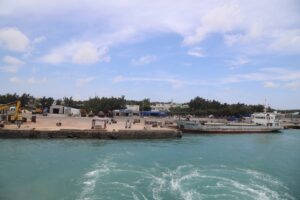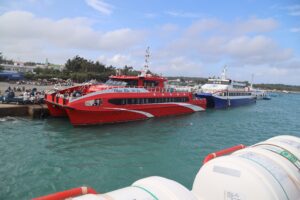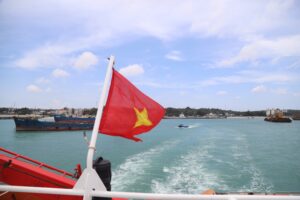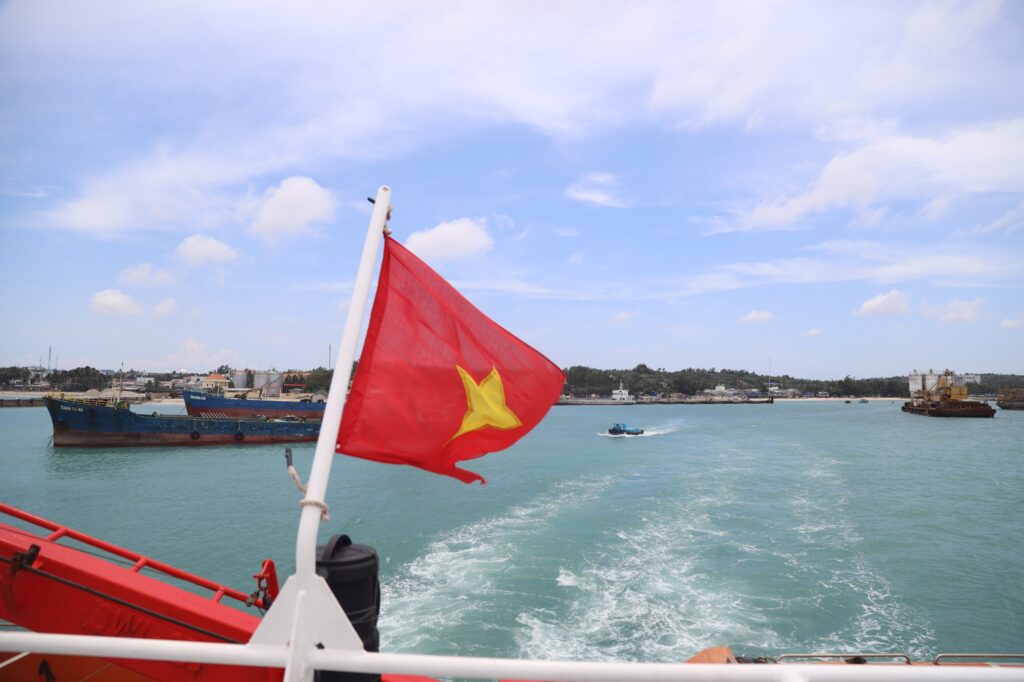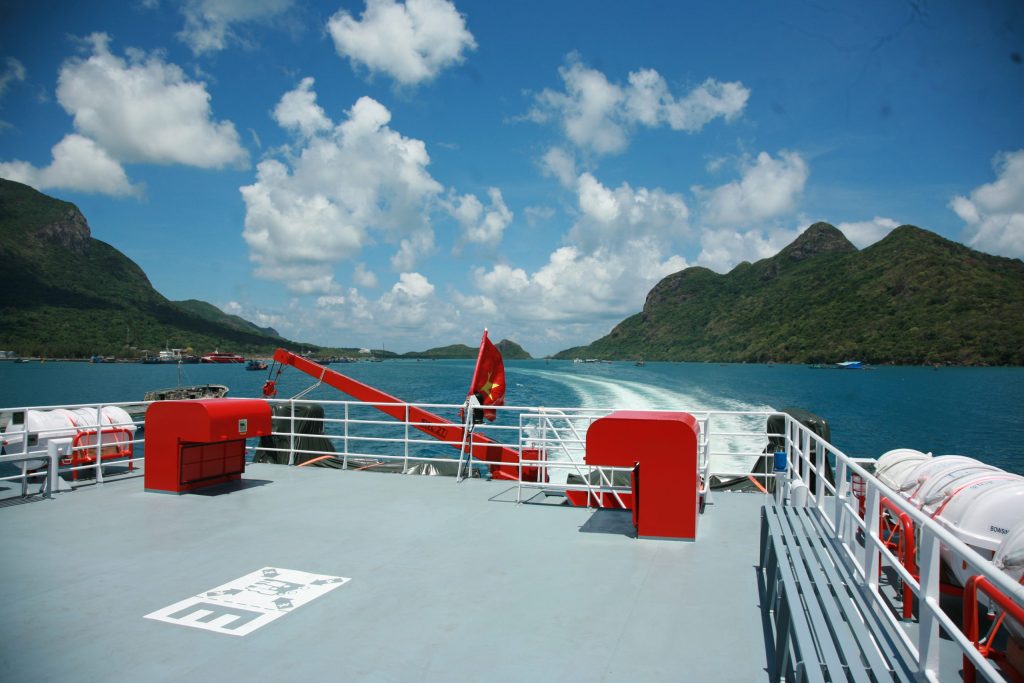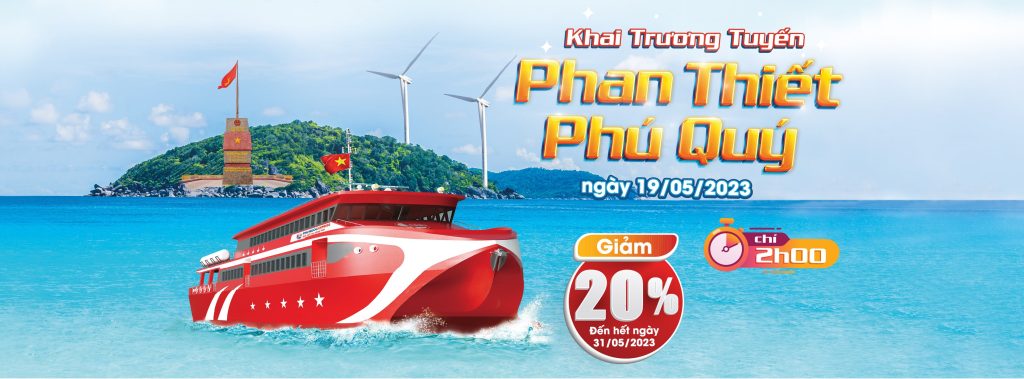Tran Bac Temple on Hon Tranh Island was established in the early 19th century. The temple complex faces southwest, welcoming the sea breeze and the gentle golden light of dusk. To the left is Thanh Long (the Blue Dragon), and to the right is Bach Ho (the White Tiger), both guarding the temple. Behind the temple lies Huyen Vu hill (the Black Turtle), and in front is Chu Tuoc (the Red Phoenix). The spacious courtyard forms a very auspicious feng shui landform for the tomb. This is a small temple without the typical triple-arched gate seen in many other temples. To the right of the temple is the mausoleum honoring 72 Nam Hai whales that died simultaneously (according to local legend, for unknown reasons, 72 whales died and washed ashore on Hon Tranh Island at the same time. The locals held a burial ceremony, built a mausoleum, and enshrined the jade bones of these 72 whales for worship).
The temple was restored in 1994. In front is a wide yard paved with Bat Trang tiles. The temple is simply arranged but has a venerable, ancient atmosphere. Above the roof ridge is the inscription “Miếu Trấn Bắc” and Chinese characters above: “Bắc Trấn Miếu – Thái Bảo Phủ Quân.”
Upon entering the main hall, one immediately notices the horizontal board with three Chinese characters “Hưng Đạo Vương” hanging right above the entrance. On the altar at the center of the main hall are two spirit tablets of Bùi Quận Công and the goddess Thiên Y A Na, alongside a portrait of Trần Hưng Đạo. Two cabinets on the left and right enshrine the ancestors and later generations. The inscription on Bùi Quận Công’s spirit tablet reads: “Respectfully inviting the Supreme Deity Bùi Quận Công, Admiral of the Northern Garrison, Governor and Protector.” In translation: “Respectfully inviting Supreme Deity Bùi Quận Công, Admiral of the Northern Garrison, Governor and Protector to take residence.”
Who was Tran Bac Bùi Quận Công? Based on the spirit tablet, “Tran Bac” was from the Bùi family, holding the title of Admiral of the Northern Garrison and Governor Protector Duke. According to Đại Nam Liệt truyện Tiền biên (The Preliminary Records of Đại Nam’s Distinguished Men), the title was granted to Bùi Tá Hán. The people affectionately call him “Ông Trấn Bắc” (Lord of the Northern Garrison) – a man renowned for his justice and pioneering work in Quảng Nam in the 17th century. Bùi Tá Hán (1496–1568) was from Chương Nghĩa district, Quảng Ngãi. He served in the Lê dynasty, rising from a minor local official (titled thổ quan) to Admiral of the Northern Garrison, Governor of Quảng Nam, and Protector Duke. He was known for his benevolence and kindness towards soldiers and civilians, earning great respect.
In the year Mậu Ngọ (1558), when the founding emperor Nguyễn Hoàng first took control of Thuận Hóa in the south, the enemy from the north (Mạc dynasty forces) often raided. Bùi Tá Hán led Quảng Nam troops to support, preventing enemy invasions. He also frequently led campaigns against hostile tribes in Đá Vách, Quảng Ngãi, establishing six fortresses along the mountains to secure the border, ensuring peace. He was one of the founding generals during the early southward expansion.
He died in the year Mậu Thìn (1568), the 11th year of the founding emperor’s reign, and was posthumously awarded the title Thái Bảo. Later, he reportedly appeared in spiritual manifestations, and the court ordered the locals to build a temple to honor him, providing ceremonial robes and items for worship. In the 13th year of Minh Mạng (1834), he was posthumously bestowed the title Khuông Quốc Tĩnh Biên Thụ Đức Thượng Đẳng Thần (Supreme Deity who supports the nation and pacifies the border).
In Phú Quý, there is a legend that during battles against the Tây Sơn rebels, when Nguyễn Ánh’s forces were defeated, he and his generals often fled to Phú Quý Island for refuge. The temple worships Bùi Huy Ích, an admiral who protected Nguyễn Ánh and helped him escape the Tây Sơn. On Hon Tranh Island, some relics related to Nguyễn Ánh and his generals remain, including a freshwater well known as “Gia Long Well” in memory of the times Nguyễn Ánh and his commanders lived and drew water there.
The Tran Bac Temple complex includes the main gate, the main hall, the smoke house, and the mausoleum for the Nam Hải deity (whale). About 200 meters southeast of the temple is Gia Long Well, which is 7 meters deep, built with coral stone walls, 80 cm high, 1.2 m in diameter. The well has fresh water year-round, unlike nearby wells with salty water. Gia Long Well has long been the freshwater source for the military camps stationed on Hon Tranh Island.
Inside the temple, Chinese-Nôm couplets are carved. One such couplet reads:
“Thánh đức phù bang, ủng dũng thanh danh phong Trác vĩ
Thần công phụ thế, thông tri phổ đạt thưởng Tĩnh biên”
Translated roughly as:
“Holy virtue protects the nation, brave and renowned, worthy of the title Trác Vĩ
Divine merit aids the world, comprehending all matters, deserving the title Tĩnh Biên”
On the decorative canopy on either side are raised Chinese-Nôm characters in plaster:
“Sinh vi tướng phù nguy vĩ các
Hóa tồn thần tế khốn nhân gian”
Translated:
“Born as a general to rescue all dangers
Died as a god to save suffering humanity”
Nguyễn dynasty emperors granted Tran Bac Admiral three royal decrees and instructed three villages—Hội An, Triều Dương, Mỹ Khê—to worship him. One decree from the second year of Emperor Đồng Khánh’s reign honored the Admiral and Nam Hải’s great whale spirit. These decrees are kept at Vạn An Thạnh, and on the festival days at Tran Bac Temple, the decrees are paraded from Vạn An Thạnh to the temple for worship and then returned.
Every year, Tran Bac Temple holds two main ceremonies: on the 12th day of the third lunar month to honor Lady Thiên Y A Na (Lady Jade Queen) and on the 7th day of the eighth lunar month to honor Lord Tran Bac. The ceremonies follow the same procedures as those at Vạn An Thạnh. Because the temple is on the small Hon Tranh Island, few visitors come, leaving the place quiet, solemn, mysterious, but very clean, as many fishermen come to pray for calm seas and bountiful harvests after long voyages.
Leaving the temple at sunset, the pale golden light fades, flocks of sea swallows return noisily after a day of exhausting migration. The boat parts the waves and glances back to the moss-covered, ancient Tran Bac Temple, fading into the misty night. One feels deep gratitude to the ancestors who pioneered and built this sacred site—a timeless legacy to be preserved and passed on. History flows endlessly, and cultural values will gradually fade if we do not protect and promote this heritage.



